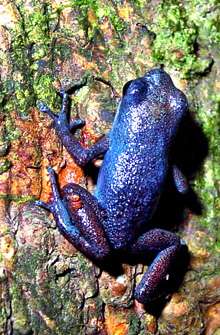Frogs' bright colors cue scientists to diversity

Tiny poison dart frogs living wild in Panama may provide clues about relatively rapid biodiversification, says Tulane University evolutionary biologist Corinne “Cori” Richards-Zawacki. Her team of students has spent most of the summer at two field sites on an archipelago studying natural selection.
“I work out most of the logistics, and then I bow out,” letting the students gain experience as researchers, says Richards-Zawacki, an assistant professor of ecology and evolutionary biology.
Aposematism — the combination of toxicity and bright coloration — is the major defense mechanism of the poison dart frogs. In Panama, these frogs have skin with a variety of colors: blue, green, red, orange, white and spotted.
“Their coloration is an advertisement of sorts, saying ‘do not attempt to eat!’” says Richards-Zawacki.

In one experiment, the students observe the behavior of chicks upon spotting the vividly hued frogs. The students’ observations will answer questions about how predators hunt frogs based on coloration.
“The chicks pick up the frogs in their beaks, but the frogs taste bad so they spit them out right away,” says Richards-Zawacki. “Do the chicks avoid all of the colors — green and blue, as well as red? Or just the color that they’ve learned to avoid?”
Neither the chicks nor frogs are harmed by the taste-testing, she says.
The team also is looking at how barriers to reproduction may influence diversification.
“Understanding how we got the diversity of life here on Earth is important for conservation,” Richards-Zawacki says. “If we want to conserve a species, we also need to conserve its ability to adapt and undergo natural evolutionary processes.”
More information: An August issue of Molecular Ecology features a paper by Richards-Zawacki, “Mate choice and the genetic basis for colour variation in a polymorphic dart frog: inferences from a wild pedigree,” with one of the team’s photos on the cover.
Provided by Tulane University

















